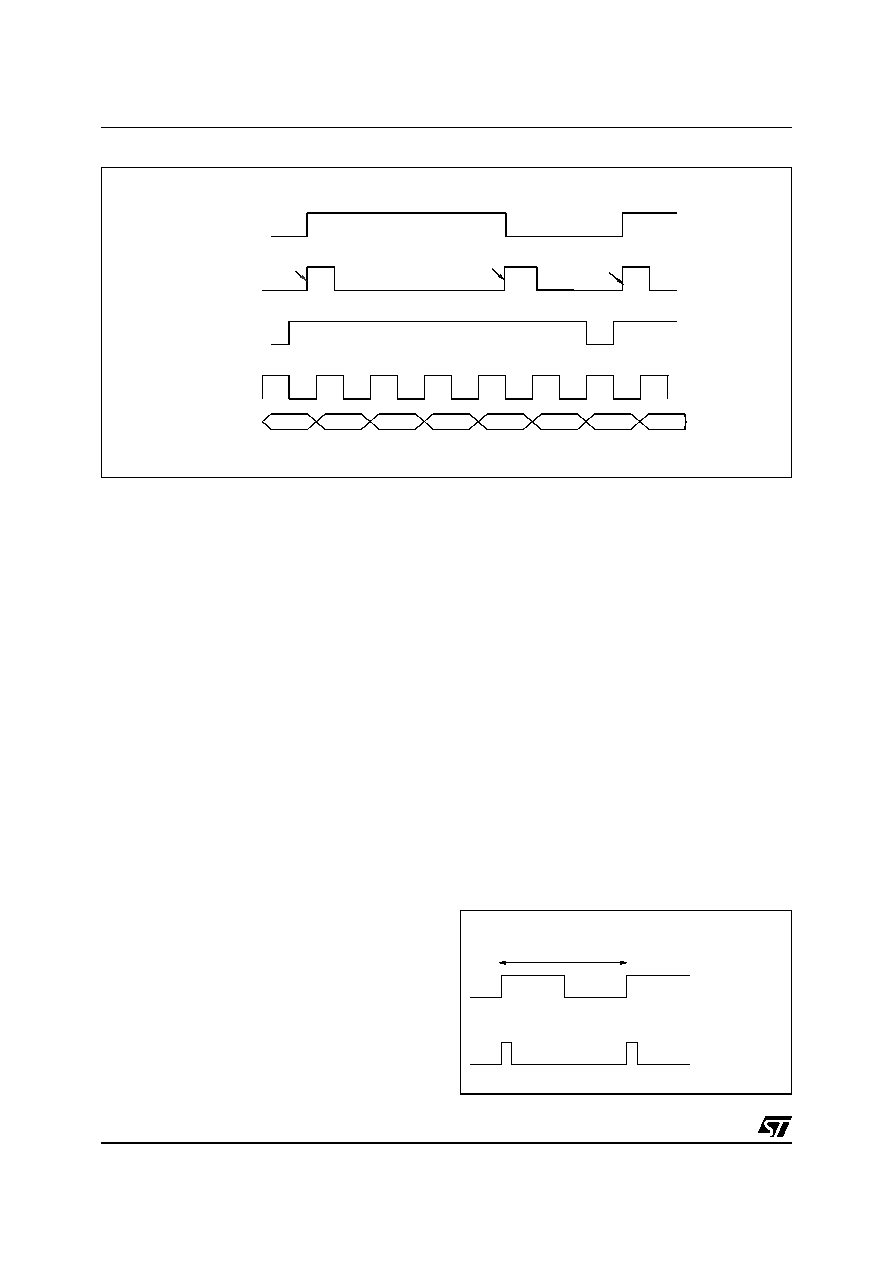- 您現(xiàn)在的位置:買賣IC網(wǎng) > PDF目錄98143 > ST52F513G3B6 (STMICROELECTRONICS) 8-BIT, FLASH, 24 MHz, MICROCONTROLLER, PDIP28 PDF資料下載
參數(shù)資料
| 型號: | ST52F513G3B6 |
| 廠商: | STMICROELECTRONICS |
| 元件分類: | 微控制器/微處理器 |
| 英文描述: | 8-BIT, FLASH, 24 MHz, MICROCONTROLLER, PDIP28 |
| 封裝: | PLASTIC, DIP-28 |
| 文件頁數(shù): | 77/106頁 |
| 文件大小: | 1340K |
| 代理商: | ST52F513G3B6 |
第1頁第2頁第3頁第4頁第5頁第6頁第7頁第8頁第9頁第10頁第11頁第12頁第13頁第14頁第15頁第16頁第17頁第18頁第19頁第20頁第21頁第22頁第23頁第24頁第25頁第26頁第27頁第28頁第29頁第30頁第31頁第32頁第33頁第34頁第35頁第36頁第37頁第38頁第39頁第40頁第41頁第42頁第43頁第44頁第45頁第46頁第47頁第48頁第49頁第50頁第51頁第52頁第53頁第54頁第55頁第56頁第57頁第58頁第59頁第60頁第61頁第62頁第63頁第64頁第65頁第66頁第67頁第68頁第69頁第70頁第71頁第72頁第73頁第74頁第75頁第76頁當(dāng)前第77頁第78頁第79頁第80頁第81頁第82頁第83頁第84頁第85頁第86頁第87頁第88頁第89頁第90頁第91頁第92頁第93頁第94頁第95頁第96頁第97頁第98頁第99頁第100頁第101頁第102頁第103頁第104頁第105頁第106頁

Figure 12.2 Timer 0 External Start/Stop Mode
TxSTRT
signal
starts/stops
the
Timer
from
counting only if the peripherals are configured in
Timer mode. The Timers are started by writing 1 in
the TXSTRT bit of the PWMx_CR1 and are
stopped by writing 0. This signal can be generated
internally and/or externally by forcing the TSTRT
pin (only TIMER0).
TIMER 0 START/STOP can be given externally on
the TSTRT pin. In this case, the T0STRT signal
allows the user to work in two different configurable
modes (see Figure 12.2):
s
LEVEL (Time Counter): If the T0STRT signal is
high, the Timer starts counting. When the
T0STRT is low the timer stops counting and the
16-bit current value is stored in the
PWM0_COUNT_IN_x Input Registers couple.
s
EDGE (Period Counter): After reset, on the first
T0STRT rising edge, TIMER 0 starts counting
and at the next rising edge it stops. In this
manner the period of an external signal may be
measured.
The same above mentioned modes, can be used
to reset the Timer0 by using the TRES pin signal.
The polarity of the T0SRTR Start/Stop signal can
be changed by setting the STRPOL and RESPOL
bits in the INT_POL Configuration Register (01h bit
3 and 4). When these bits are set, the PWM/Timer
0 is Started/Set on the low level or in the falling
edge of the signal applied in the pins.
The Timer output signal, TxOUT, is a signal with a
frequency equal to the one of the 16 bit-Prescaler
output signal, PRESCOUTx, divided by a 16-bit
counter set by writing the Output Register couple
PWMx_COUNT_OUT_x.
Note: the contents of these registers upgrades the
Timer counter after it stops counting. Since the
register couple is written in two steps this can
cause side effects. In order to avoid this, the user
should write the MSB before writing the LSB:
actually, the 16-bit value is latched in parallel when
the LSB is written. By writing only the LSB (and
MSB equal to 0), the PWM/Timer is used as with
an 8 bit counter.
Warning: in Timer Mode the Reload Register
couple PWMx_RELOAD_x (see PWM mode) must
be set to the higher value FFFFh (65535)
otherwise it can affect the count duration.
There can be two types of TxOUT waveforms:
s
type 1: TxOUT waveform equal to a square
wave with a 50% duty-cycle
s
type 2: TxOUT waveform equal to a pulse signal
with the pulse duration equal to the Prescaler
output signal.
Figure 12.3 TxOUT Signal Types
Level
Ed ge
sta rt
sto p
start
stop
start
01
1
0
4
3
2
Reset
Clock
Cou nted
Va lue
Timer Output
Type 1
Type 2
Prescout*Counter
相關(guān)PDF資料 |
PDF描述 |
|---|---|
| ST52F513Y1B6 | 8-BIT, FLASH, 24 MHz, MICROCONTROLLER, PDIP16 |
| ST52F513Y2B6 | 8-BIT, FLASH, 24 MHz, MICROCONTROLLER, PDIP16 |
| ST52F510Y3B6 | 8-BIT, FLASH, 24 MHz, MICROCONTROLLER, PDIP16 |
| ST52F514Y2B6 | 8-BIT, FLASH, 24 MHz, MICROCONTROLLER, PDIP16 |
| ST52T430K3B6 | 8-BIT, OTPROM, 20 MHz, MICROCONTROLLER, PDIP32 |
相關(guān)代理商/技術(shù)參數(shù) |
參數(shù)描述 |
|---|---|
| ST52F513GMB6 | 制造商:STMICROELECTRONICS 制造商全稱:STMicroelectronics 功能描述:8-BIT INTELLIGENT CONTROLLER UNIT ICU Two Timer/PWMs, ADC, I2C, SPI, SCI |
| ST52F513GMM6 | 制造商:STMICROELECTRONICS 制造商全稱:STMicroelectronics 功能描述:8-BIT INTELLIGENT CONTROLLER UNIT ICU Two Timer/PWMs, ADC, I2C, SPI, SCI |
| ST52F513Y3M6 | 制造商:STMicroelectronics 功能描述: |
| ST52F513YMM6 | 制造商:STMICROELECTRONICS 制造商全稱:STMicroelectronics 功能描述:8-BIT INTELLIGENT CONTROLLER UNIT ICU Two Timer/PWMs, ADC, I2C, SPI, SCI |
| ST52F514 | 制造商:STMICROELECTRONICS 制造商全稱:STMicroelectronics 功能描述:8-BIT INTELLIGENT CONTROLLER UNIT ICU Two Timer/PWMs, ADC, I2C, SPI, SCI |
發(fā)布緊急采購,3分鐘左右您將得到回復(fù)。